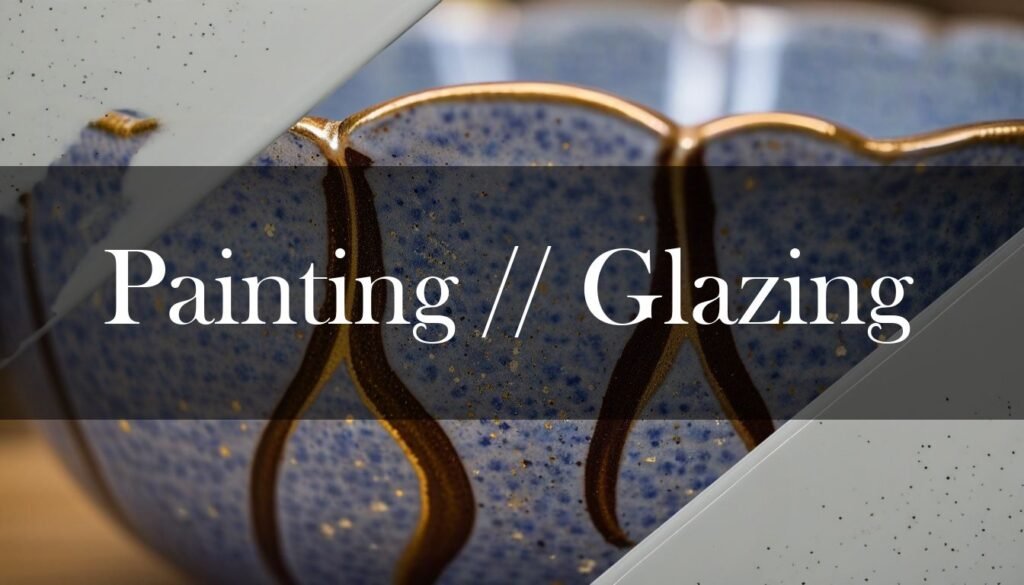Painting and glazing ceramics at home can be a wonderfully rewarding experience, allowing you to infuse your personal touch into every piece you create. Whether you’re giving new life to an old ceramic or adding intricate designs to a newly formed piece, the process involves several key steps to ensure a professional and lasting finish.
First, preparing your ceramic piece is crucial. This begins with a thorough cleaning using warm, soapy water to remove any dust, dirt, or grease that could interfere with paint adhesion. If the ceramic has a glossy finish, lightly sanding it with 150-grit sandpaper will create a textured surface, enhancing how well the paint sticks. After sanding, wiping off any dust with a clean cloth is essential. Applying a primer designed for non-porous surfaces can further improve paint adhesion. Once the primer is fully dry, you’re ready to paint.
Choosing the right type of paint is vital. Acrylic paints are excellent for decorative items due to their wide color range and quick drying time, while enamel paints are better suited for functional items like mugs, as they provide a durable, water-resistant finish. Apply the paint in thin, even coats, allowing each coat to dry completely before adding the next to achieve a smooth and vibrant finish. After the paint has dried completely, protect your work with a clear sealant or varnish to enhance the durability of the paint, giving it either a glossy or matte finish depending on your preference. For certain paints, curing the painted ceramic in an oven at 140°C (284°F) for about 30 minutes can help the paint bond securely to the ceramic surface, ensuring a lasting finish.
When it comes to glazing ceramics without a kiln, several techniques can be employed to achieve unique and beautiful results. For air-dry clay, after your piece hardens, you can apply acrylic or enamel glazes, which often dry quickly and can be layered for a richer finish. Applying a sealant after the glaze dries can enhance its durability and add a glossy finish. Alcohol-based glazes are another excellent option for a glossy, sheer finish, drying quicker than other types.
The wax resist technique involves applying melted wax to areas of your ceramic piece to resist glaze, creating intricate patterns. Once the wax dries, apply glaze over the entire surface, and after the glaze is dry, remove the wax to reveal the design. For more controlled application, brush-on glazes allow for detailed designs, applying thin, even coats and allowing each coat to dry completely before applying additional layers. Spray-on glazes, using an airbrush or spray can, are effective for achieving a smooth, even finish. Dipping your piece into a glaze ensures a uniform coating, while pouring glaze over your piece allows for controlled application, especially for larger items, creating interesting patterns and textures.
Remember to ensure your ceramic piece is clean and dry before applying glaze to promote better adhesion, apply multiple thin layers to prevent drips, and allow each layer to dry completely to avoid smudging.
Safety is paramount when working with ceramic paints and glazes, so always work in a well-ventilated area and wear protective gear, especially when using sprays or chemicals. When mixing dry clay or glazes, wear a respirator to prevent inhalation of fine particles. Use gloves when handling wet or dry glazes to prevent skin contact with potentially hazardous substances, and wear safety goggles to shield your eyes from splashes and airborne particles. Avoid dry sweeping, which can disperse dust into the air; instead, use wet methods such as mopping or sponging to clean floors and surfaces.
Opt for lead-free glazes, especially for items intended for food use, and avoid using glazes containing highly toxic metals such as lead, cadmium, arsenic, or uranium. Familiarize yourself with the Material Safety Data Sheets (MSDS) for all materials used to understand their hazards and recommended safety measures. By following these steps and safety precautions, you can confidently and creatively paint and glaze ceramics at home, creating beautiful, personalized pieces that reflect your unique style.





